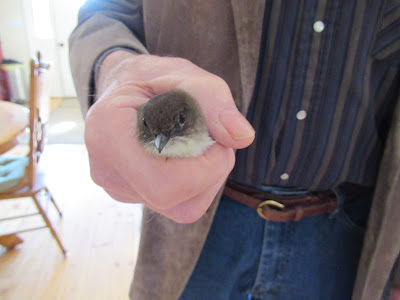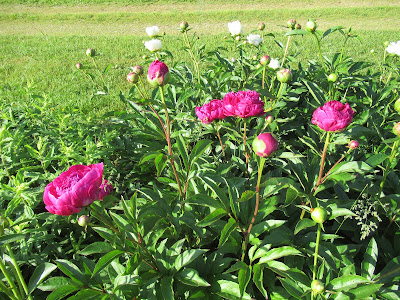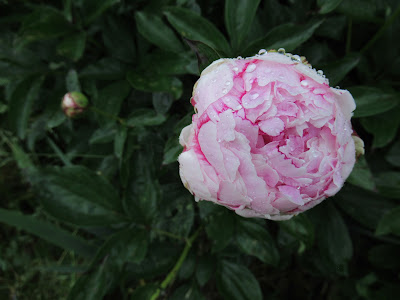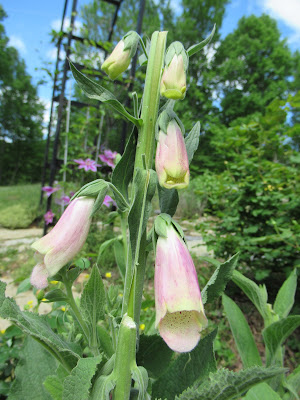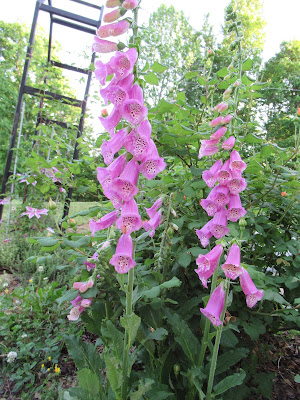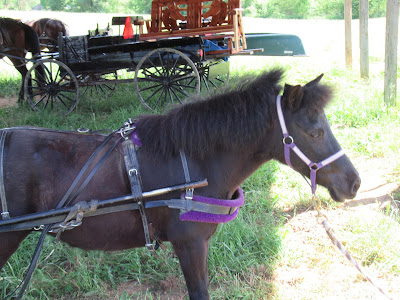Kildeers are present here through all seasons. They dive low over the pastures and lane, swooping in tight circles, landing a few yards ahead to run in zig-zag patterns, while uttering their distinctive, "Kil-dee, kil-dee.'
In early May on my daily walks out to the mailbox near the road, I noticed one particularly agitated bird alternately flying up from the ground, then dropping to stagger along the graveled lane, squawking loudly.
I noted a particular fence post opposite as a landmark and next day carried my camera.
Even knowing where the 'nest' might be, it was difficult to locate the eggs. On an overcast day their mottled coloring blended well with the coarsely crushed rocks which line the sloping ditch above the lane.
I used the camera's zoom for a less than sharp photo, not wanting to risk unwittingly stepping on the eggs or getting too close and sending the mother bird into a panic.
Research online indicates that both kildeer parents incubate the eggs, the female usually taking daytime duties while the male takes over during the night hours. There is a high rate of loss since the eggs are laid directly on the ground where livestock may tread. As soon as their feathers dry the young are able to skitter about and search for food, although they are not able to fly immediately.
The parent bird is trying to distract me, leading me away from the eggs.
The baby kildeers have hatched and are now running about with the adult birds.
Walking to the mailbox this week I found two feathers lying on the ground several yards apart.
The one on the right is identifiable as a kildeer's wing feather. The feather on the left is not so easily identified.
I recognize many of the more common birds in the area. We have nesting bluebirds, cardinals, robins; barn swallows are taking advantage of the barn loft, several species of woodpeckers live year around in the trees that line the ravines. Gold finches are very noticeable in late summer when seed heads are ripening on the sunflowers.
Wild turkeys are frequent visitors, strolling through the fields. They are easily spooked and scuttle off, sometimes lumbering into clumsy flight no matter how quietly I slide out the door.
This photo was taken through a window screen.
Deer often wander across the east meadow or browse in small groups at the western end of the property, melting quietly into the tree line when they realize they have been seen.
We've noticed a doe recently who seemed about to give birth. This morning Jim spotted her in the meadow above the garden, a tiny fawn with her. I eased through the back door and walked quietly around to the barn and along the side 'alley' to stand in the open end. I was able to take only one zoomed photo before the deer was off, baby in tow. When the photo is enlarged you can see that the fawn is attempting to nurse while the doe peers warily over her shoulder in my direction.
The guineas, appearing at the end of February, are not strictly wildlife. They are vagrants with no fixed address. Usually they appeared as a flock of eight, although they have meandered about in smaller groups. Sometimes they have disappeared for several days or less than the whole group comes by. We usually know when they are about--they are noisy and the cats alert us to their presence.
It has now been nearly three weeks since we've seen them.
I've wondered if they would become a nuisance should they stay around as the garden comes on; I can imagine greedy pecking of tomatoes, melons and such.
Still, I hope they are alive and well--somewhere--and they may return.
Squirrels are everywhere. In winter and early spring their untidy nests are visible in the trees along the lane. Once the leaves are out the nests blend in, but sitting quietly on the screened porch I will notice the trembling of a branch and can then follow the progress of a squirrel or several as they leap and bounce from one tree to another.
This squirrel was harvesting a black walnut that had lain on the ground over the winter. He/she was quite bold, scampering about while I stood near, then whisking up to a comfortable branch and nonchalantly settling in for lunch.
Driving the mile to the Beachy's farm market earlier this week, I slowed to let a squirrel dash in front of my car and was surprised to see that a group of squirrels was cavorting madly about in the short grass just off the roadway. I took note of the spot--a wide swath of green, some shrubs, a few trees. On the way home I slowed, trying to count the squirrels who were still chasing and tumbling about. I settled on seven, although they were so busy it was difficult to keep an eye on them.
this little bird was apparently thinking of creating a home in the upper reaches of the chimney. Jim decided to burn an accumulation of paper in the woodstove and the bird flew out the door into the room. It flung itself against window panes, swirling up to the ceiling, frantic and elusive. It didn't help that several felines were in fascinated pursuit.
Jim finally caught it as it fluttered against a window. He tossed it from the front steps and it flew away.
This racoon has been making early evening forays, hoping to find a few morsels remaining in the dish that serves the barn cats. Coons have a cuteness that makes them more welcome than opossums, but I'm aware that they can be mischievous.
Several years ago a huge male coon overturned planters, dug up clematis vines, scrabbled in the raised bed near the door until Howard and I live trapped him and took him for a ride.
We were watching him/her through the window high up in the door. Although momentarily startled when the camera flashed, you can see he continued to pick up the last morsels in the dish.
Deer, racoons, possums, can all be a menace to our gardening efforts. During the remainder of the year most creatures are welcome as interesting transients.








